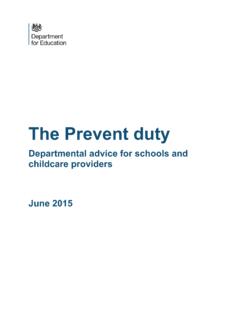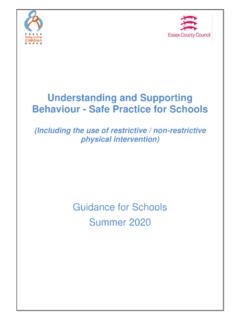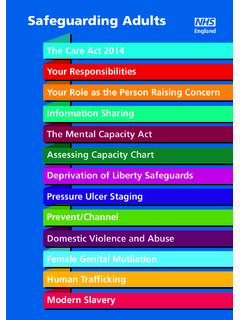Transcription of Working Together to Safeguard Children 2018 - GOV.UK
1 Working Together to Safeguard Children A guide to inter-agency Working to Safeguard and promote the welfare of Children July 2018 2 Contents Contents 2 Introduction 6 About this guidance 7 What is the status of this guidance? 7 Who is this guidance for? 9 A child centred approach to safeguarding 9 A co-ordinated approach safeguarding is everyone s responsibility 11 Chapter 1: Assessing need and providing help 13 Early help 13 Identifying Children and families who would benefit from early help 13 Effective assessment of the need for early help 15 Provision of effective early help services 16 Accessing help and services 16 Referral 17 Information sharing 18 Statutory requirements for Children in need 22 Homelessness Duty 23 Assessment of disabled Children and their carers 24 Assessment of young carers 24 Assessment of Children in secure youth establishments 24 Assessment of risk outside the home 25 Purpose of assessment 26 Local protocols for assessment 26 The principles and parameters of a good assessment 27 Assessment Framework 30 Focusing on the needs and views of the child 30
2 Developing a clear analysis 31 Focusing on outcomes 32 Timeliness 33 3 Processes for managing individual cases 34 Flow chart 1: Action taken when a child is referred to local authority Children s social care services 35 Flow chart 2: Immediate protection 37 Assessment of a child under the Children Act 1989 38 Flow chart 3: Action taken for an assessment of a child under the Children Act 1989 40 Strategy discussion 41 Flow chart 4: Action following a strategy discussion 44 Initiating section 47 enquiries 45 Outcome of section 47 enquiries 47 Initial child protection conferences 49 The child protection plan 51 Child protection review conference 53 Flow chart 5: What happens after the child protection conference, including the review?
3 54 Discontinuing the Child Protection Plan 55 Flow chart 6: Children returning home from care to their families 57 Chapter 2: Organisational responsibilities 58 Section 11 of the Children Act 2004 58 People in positions of trust 60 Individual organisational responsibilities 61 Schools, colleges and other educational providers 61 Early Years and Childcare 62 Health 62 designated health professionals 64 Public Health England 65 Police 65 Adult social care services 66 Housing services 67 British Transport Police 67 Prison Service 68 Probation Service 69 4 Children s homes 70 The secure estate for Children 70 Youth Offending Teams 71 UK Visas and Immigration, Immigration Enforcement and the Border Force 71 Children and Family Court Advisory and Support Service 72 Armed Services 72 Multi-Agency Public Protection Arrangements 73 Voluntary.
4 Charity, social enterprise, faith-based organisations and private sectors 73 Sports Clubs / Organisations 74 Chapter 3: Multi-agency safeguarding arrangements 75 safeguarding partners 75 Leadership 76 Geographical area 77 Relevant agencies 78 Schools, colleges and other educational providers 79 Information requests 79 Independent scrutiny 80 Funding 81 Publication of arrangements 81 Dispute resolution 82 Reporting 82 Chapter 4: Improving child protection and safeguarding practice 84 Overview 84 Purpose of child safeguarding practice reviews 84 Responsibilities for reviews 85 Duty on local authorities to notify incidents to the Child safeguarding Practice Review Panel 86 Decisions on local and national reviews 86 The rapid review 88 Guidance for the national Child safeguarding Practice Review Panel 89 Commissioning a reviewer or reviewers for a local child safeguarding practice review 91 5 Local child safeguarding practice reviews 91 Expectations for the final report 92 Actions in response to local and national reviews 93 Guidance for the Child safeguarding Practice Review Panel reviewers 94 The Panel expectations for the final report
5 94 How to notify a serious incident, rapid review, and local child safeguarding practice review 96 Chapter 5: Child death reviews 97 Statutory Requirements 98 Responsibilities of Child Death Review Partners 99 Responsibilities of other organisations and agencies 100 Specific responsibilities of relevant bodies in relation to child deaths 101 Responding to the death of a child: the child death review process 102 Flow Chart 7: Process to follow when a child dies 102 Appendix A: Glossary 106 Appendix B: Further sources of information 112 Department for Education guidance 112 Guidance issued by other government departments and agencies 113 Guidance issued by external organisations 114 6 Introduction Nothing is more important than Children s welfare.
6 Children1 who need help and protection deserve high quality and effective support as soon as a need is identified. We want a system that responds to the needs and interests of Children and families and not the other way around. In such a system, practitioners2 will be clear about what is required of them individually, and how they need to work Together in partnership with others. Whilst it is parents and carers who have primary care for their Children , local authorities, Working with partner organisations and agencies, have specific duties to Safeguard and promote the welfare of all Children in their area. The Children Acts of 1989 and 2004 set out specific duties: section 17 of the Children Act 1989 puts a duty on the local authority to provide services to Children in need in their area, regardless of where they are found; section 47 of the same Act requires local authorities to undertake enquiries if they believe a child has suffered or is likely to suffer significant harm.
7 The Director of Children s Services and Lead Member for Children s Services in local authorities are the key points of professional and political accountability, with responsibility for the effective delivery of these functions. These duties placed on the local authority can only be discharged with the full co-operation of other partners, many of whom have individual duties when carrying out their functions under section 11 of the Children Act 2004 (see chapter 2). Under section 10 of the same Act, the local authority is under a duty to make arrangements to promote co-operation between itself and organisations and agencies to improve the wellbeing of local Children (see chapter 1). This co-operation should exist and be effective at all levels of an organisation, from strategic level through to operational delivery.
8 The Children Act 2004, as amended by the Children and Social Work Act 2017, strengthens this already important relationship by placing new duties on key agencies in a local area. Specifically, the police, clinical commissioning groups and the local authority are under a duty to make arrangements to work Together , and with other partners locally, to Safeguard and promote the welfare of all Children in their area. Everyone who comes into contact with Children and families has a role to play. safeguarding and promoting the welfare of Children is defined for the purposes of this guidance as: 1 In this document, a child is defined as anyone who has not yet reached their 18th birthday. Children therefore means Children and young people throughout.
9 2 The term practitioners is used throughout the guidance to refer to individuals who work with Children and their families in any capacity. 7 protecting Children from maltreatment preventing impairment of Children s mental and physical health or development ensuring that Children grow up in circumstances consistent with the provision of safe and effective care taking action to enable all Children to have the best outcomes About this guidance 1. This guidance covers: the legislative requirements placed on individual services a framework for the three local safeguarding partners (the local authority; a clinical commissioning group for an area, any part of which falls within the local authority; and the chief officer of police for a police area, any part of which falls within the local authority area) to make arrangements to work Together to Safeguard and promote the welfare of local Children including identifying and responding to their needs the framework for the two child death review partners (the local authority and any clinical commissioning group for an area, any part of which falls within the local authority) to make arrangements to review all deaths of Children normally resident in the local area, and if they consider it appropriate, for those not normally resident in the area 2.
10 This document replaces Working Together to Safeguard Children (2015). Links to relevant supplementary guidance that practitioners should consider alongside this guidance can be found at Appendix B. What is the status of this guidance? 3. This guidance applies to all organisations and agencies who have functions relating to Children . Specifically, this guidance applies to all local authorities, clinical commissioning groups, police and all other organisations and agencies as set out in chapter 2. 4. It applies, in its entirety, to all schools. 5. It applies to all Children up to the age of 18 years whether living with their families, in state care, or living independently. 6. This document should be complied with unless exceptional circumstances arise.














